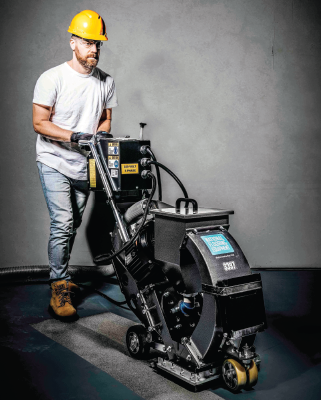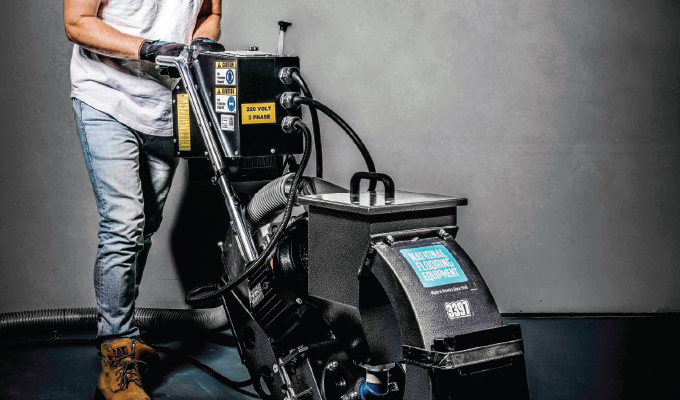One of the biggest mistakes in gardening is failing to prepare the soil properly—by loosening the soil and adding organic matter before planting, gardeners can set themselves up for success. Similarly, correct surface preparation is the key to obtaining beautiful flooring that lasts for decades. Here Claude Besson, country manager for France at surface preparation expert National Flooring Equipment, explains the best techniques for concrete profiling.
Concrete surface profile (CSP) is a standardized measure for the roughness of a surface that has been established by the International Concrete Repair Institute (ICRI). It is expressed with a number from one to nine, where nine represents the roughest finish possible. There are several methods to obtain the ideal CSP for your application, which can be grouped in two broad categories: mechanical and chemical.
MECHANICAL METHODS
Before starting any concrete profiling, it is important to remove the old coatings with appropriate technologies, such as walk-behind or ride-on scrapers. In this way, the removal will be achieved in minimal time, saving a lot of labor and fatigue, and damaging the substrate as little as possible. This will also allow the operator to limit the amount of dust and broken parts generated while removing the old material. This step is effective if operators use the appropriate blades and shanks, which will optimise tooling-related costs.
After this step, one of the most commonly used techniques for mechanical concrete profiling is abrasion. In this method, diamond grinding erodes the surface and causes a progressive disintegration of the concrete, which results in a flat and relatively uniform surface. Abrasion leads to minimal surface damage and results in a very low CSP, usually around one to three.
Contractors can also use differences in heat to profile a surface, a method known as expansive pressure. In this approach, the surface is heated quickly to a high temperature, causing the top to peel off. This is usually done with flame blasting, high pressure water jetting, or steam blasting, and results in a rough surface with a CSP of six to nine.
To preserve the surface as much as possible, pulverisation can be the way to go. Small particles travelling at a high speed collide against the surface, removing the top layer. This method causes minimal damage to the surface and can result in a broad range of CSPs, from two to eight. Pulverisation is commonly done by abrasive blasting—also known as sandblasting—and shot blasting.
Lastly, when a very rough profile is needed, contractors can consider the impact technique, which is usually done with a bush hammer or scarifier. In this method, the substrate crumbles as a result of repeated impact by a hardened point, which causes the aggregate and cement paste to crack. This damages the surface considerably but allows the contractor to obtain a rough profile with a CSP ranging from four to nine.

CHEMICAL TREATMENTS
Chemical reaction may sound like an obsolete and environmentally unfriendly solution, but there are still applications in which this is necessary. If the jobsite cannot accommodate big machinery and the substrate is so compromised that hand-held devices are not powerful enough, chemical treatments might be the only solution.
This method involves applying a solution of water and muriatic or citric acid to the concrete with a low-pressure sprayer or a plastic sprinkling can remove the superficial cement paste and expose the fine aggregate. Acid treatments produce a very light profile similar to fine sandpaper. Since light profiling is suited to thin coatings, this method is ideal for microtoppings that are less than 10 mm thick.
During the chemical treatment, toxic materials can be released, so it’s essential that operators wear personal protective equipment such as goggles. It’s also important to prevent contact between machinery and acid, since this could corrode any metallic components. Lastly, operators should be aware of local regulations on how to safely dispose of acid and contaminated water.
CLOSING THOUGHT
Gardeners know that a well-prepared soil is essential for healthy and beautiful plants. Similarly, you should make sure that the floor is properly prepared to ensure that the coating or covering will adhere correctly.
For more information:
Founded in 1968, National Flooring Equipment designs and manufactures quality flooring equipment and supports it with unparalleled customer service. For more about how National Flooring Equipment can help you choose the best concrete profiling method, visit www.nationalequipment.com.
Modern Contractor Solutions, September 2020
Did you enjoy this article?
Subscribe to the FREE Digital Edition of Modern Contractor Solutions magazine.



